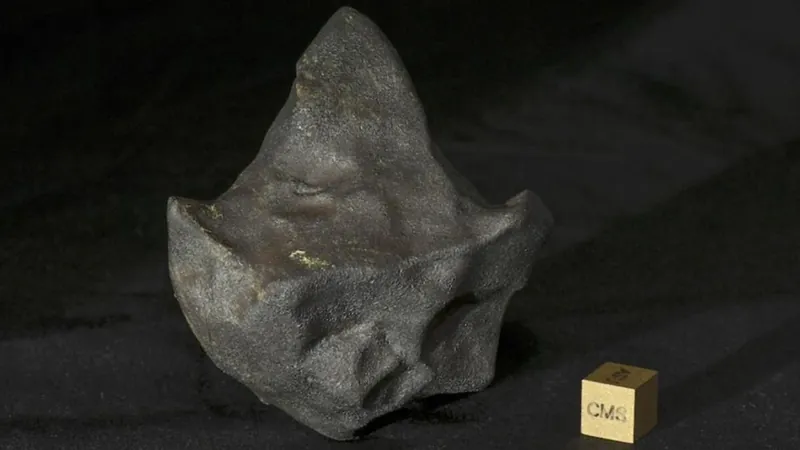
How a 'Mudball' Meteorite Defied the Odds to Land in Central America
2025-04-03
Author: Wei Ling
Introduction
In an astonishing incident, a meteorite that plunged to Earth in Costa Rica in 2019 has captivated scientists and the public alike. Referred to as 'mudballs,' these meteorites possess an intriguing composition, rich in water-containing minerals, which sets them apart from the typical meteorites we usually see—often battered and bruised from violent collisions in space.
Unique Properties of Mudball Meteorites
The meteorites, discovered near the town of Aguas Zarcas, have sparked renewed interest in their unique properties. Contrary to previous assumptions that high water content would render them weak and more susceptible to destruction upon entering Earth's atmosphere, data has shown that these 'mudballs' can, in fact, withstand the harsh conditions of space travel surprisingly well. Peter Jenniskens, a meteor astronomer affiliated with the SETI Institute and NASA Ames Research Center, stated, “The presence of water-rich minerals doesn’t mean they are fragile.”
Comparison to the Murchison Meteorite
This extraordinary discovery is being compared to the legendary Murchison meteorite fall of 1969, which is still celebrated as one of the most significant meteorite events in history. The Aguas Zarcas event led to the recovery of approximately 27 kilograms (60 pounds) of meteorite fragments, marking it as the largest fall of its kind in over five decades.
The Murchison meteorite is renowned for its rich content of organic compounds, hinting at the primordial ingredients of life, and similarly, the Aguas Zarcas meteorites may provide vital clues about the conditions in our solar system's early history. Both events occurred around pivotal moments in human exploration—the aftermath of the Apollo 11 mission for Murchison and a new era of space interest for Aguas Zarcas.
The Journey to Earth
Captured on video as it streaked across the sky, the mudball meteor composed a fiery path as it entered the Earth's atmosphere at an impressive speed of 9 miles (14.6 kilometers) per second. Its steep descent angle of 81 degrees minimized its exposure to the atmosphere, facilitating the survival of more of the original meteoroid as it raced towards Earth.
Jenniskens believes this meteor originated from a larger asteroid in the outer regions of the asteroid belt, based on its trajectory. Initially, the meteor was about 23.6 inches (60 centimeters) wide, but as it hurtled through the atmosphere, friction generated heat, leading to ablation—the process that melts away its surface, causing it to lose mass and shape.
The Aguas Zarcas Event
When the meteor shattered at an altitude of 15.5 miles (25 kilometers), it produced a dazzling flash that was detected by NASA's GOES 16 and 17 satellites. The scattered fragments eventually landed across the lush Costa Rican jungle, eagerly sought out by meteorite hunters and volunteers who recognized their potential importance.
The Aguas Zarcas fragments stand out not just for their scientific significance but also for their striking visual characteristics. Laurence Garvie from Arizona State University's Buseck Center for Meteorite Studies described them as possessing “beautiful blue iridescence” and noted the unusual rounded shapes, which suggested a relatively unscathed journey through space.
Historical Context and Significance
Scientists have even traced the history of these meteorites back about two million years, a blink of an eye in the grand timeline of our solar system, indicating they broke away from their parent body before eventually finding their way to Earth after a long cosmic voyage.
Gerardo Soto from the University of Costa Rica articulated the enormity of the Aguas Zarcas event for the country, emphasizing its historical significance in the broader context of meteoritics. He drew parallels to the Murchison event, asserting, “The fall of Aguas Zarcas was huge news in the country. It marked a pivotal moment in meteorite recovery and research.”
Conclusion
In conclusion, the Aguas Zarcas meteorites not only deepen our understanding of the cosmos but also ignite public enthusiasm for the mysteries beyond our planet. As scientists continue to study these unique specimens, we may uncover more secrets of the universe and the origins of life itself. What other astonishing discoveries await us in the heavens? Stay tuned!
 Brasil (PT)
Brasil (PT)
 Canada (EN)
Canada (EN)
 Chile (ES)
Chile (ES)
 Česko (CS)
Česko (CS)
 대한민국 (KO)
대한민국 (KO)
 España (ES)
España (ES)
 France (FR)
France (FR)
 Hong Kong (EN)
Hong Kong (EN)
 Italia (IT)
Italia (IT)
 日本 (JA)
日本 (JA)
 Magyarország (HU)
Magyarország (HU)
 Norge (NO)
Norge (NO)
 Polska (PL)
Polska (PL)
 Schweiz (DE)
Schweiz (DE)
 Singapore (EN)
Singapore (EN)
 Sverige (SV)
Sverige (SV)
 Suomi (FI)
Suomi (FI)
 Türkiye (TR)
Türkiye (TR)
 الإمارات العربية المتحدة (AR)
الإمارات العربية المتحدة (AR)